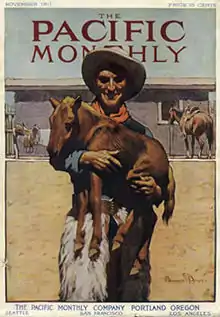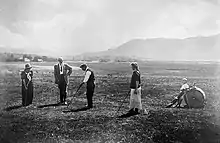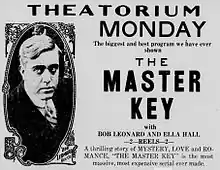John Fleming Wilson
John Fleming Wilson, (February 22, 1877 – March 5, 1922), was an American author, newspaperman, and prolific writer of short stories and adventure novels, best known for his travel books about sea life. Many of his books and short stories were made into films during the 1910s through the 1930s.
John Wilson | |
|---|---|
.jpg.webp) John Fleming Wilson (1877–1922) | |
| Born | John Fleming Wilson February 22, 1877 Erie, Pennsylvania, US |
| Died | March 5, 1922 (aged 45) Venice, California, US |
| Occupation | Writer |
| Notable works | The Man Who Came Back |
| Spouse | Elena Burt |
Early life
Wilson was born on February 22, 1877, in Erie, Pennsylvania. He was the son of Presbyterian minister Dr Joseph Rogers Wilson (1847–1929), and Viola Earl Eaton (1845–1933). His father worked with Dr. Samuel Johnson who founded the Portland Academy. He received his education at Parsons College in Iowa, and at Princeton University in 1900.[1][2] He studied classical and modern literature, particularly subjects that related to oceans, bays, rivers, and ports. He spent much of his boyhood at sea.[3] He married Elena Burt in July 1906, in Newport, Oregon. He was later divorced and had no children.[1][2]
He was a deep-sea sailor, a ship's officer in the merchant marine, wireless operator, and lived for a time in Japan. His study of nautical books and the trips out to sea gave him the opportunity to write sea stories.[4][5]
Career
Wilson was a schoolteacher from 1900 to 1902 at the Portland Academy. He then worked with a newspaper company from 1902 to 1905. He was the author of several books and contributed to short stories for both American and European magazines.[1]
Newspapers

In 1905, Wilson lived in Honolulu, Hawaii on the writing staff of The Honolulu Advertiser. A number of his stories were published in The Advertiser, in 1907 and 1908. In 1906, he was editor of the San Francisco The Argonaut,[4][1] and a member of the Bohemian Club.[6]
In 1907, he founded the Newport Signal, of Newport, Oregon.[7] He was also associated with The Oregonian and The Pacific Monthly.
In 1907, Wilson corresponded by letters to author and editor Charles Warren Stoddard (1843–1909), when Stoddard was living in Monterey, California.[8]
Carmel

In the early 1910s, Wilson lived in Carmel Point, near Carmel-by-the-Sea. He built a little cottage at 14th Avenue and San Antonio Street as a writer's studio. He gave up newspaper work and went into short story writing. Many of his stories appeared in magazines like The Pacific Monthly, Sunset, The Saturday Evening Post, and Cosmopolitan. The books he wrote while in Carmel were Across the Latitudes (1911), The Land Claimers (1911), The Man Who Came Back (1912), The Princess of Sorry Valley (1913), and The Master Key (1914).[6]
In 1912, Wilson sold the studio to realtor Philip Wilson Sr. (1862–1944) (not a relative) who also owned the Philip Wilson Building downtown, and developed the first and only Carmel Golf Course.[9][10][11]
World War I
Wilson served overseas in France with the 7th infantry battalion of the Canadian Army during World War I from 1917 to 1919. He was gassed by German shells. After the war he returned as a patient in a government hospital at Arrowhead Springs, San Bernardino. He then went to Martin's Sanitarium in Venice, California.[1]
Death
Wilson died, from burns caused by a gas heater, on March 5, 1922, at his home in Venice, at the age of 55.[1] His remains were brought to Hemet, California and funeral services were head at the San Jacinto Valley Cemetery in San Jacinto, California.[4]
Legacy
Writer Herbert Heron wrote about Wilson in the Carmel Pine Cone in 1966. He said
His stories of the sea are among the best in the language. He was especially familiar with the Oregon Coast and the treacherous Columbia River mouth. He knew ships of very kind, from tugboats to ocean liners, and he served as an officer on many of them.[3]
Raymond Blathway wrote of him and said:
As a literature he was perhaps the best equipped man I have ever known. But as a technical writer of one of the most complicated professions in the world he holds pre-emience over every other writer in that particular branch of literature. Neither Richard Henry Dana, Herman Melville, William Clark Russell, Conrad, nor Kipling can surpass him in his unrivalled knowledge of the sea and all that pertains to it.[3]
Filmography

_-_Ad_2.jpg.webp)
- The Making of a Man (1906 short story The Outing Magazine); silent drama film in 1911 Biograph Company[12][13]
- The Man Who Came Back (1912 novel); silent film in 1924[14][15][16]
- The Master Key (short story); film serial in 1914 directed by Robert Z. Leonard.[17]
- Learning to Be a Father (short story) 1915[18]
- Their Golden Wedding (short story) 1915[19]
- A Soul at Stake (short story), written by Wilson and scenarioized by Calder Johnstone; silent short Oriental drama in 1916.[20]
- Never Too Old to Woo (short story) 1917; silent film.[21]
- The Uncharted Seas (Sep 1920 short story-Munsey's Magazine); silent romance drama film 1921[22][23]
- The Bonded Woman (short story) 1922; silent drama film; from Wilson's book The Saving of John Somers[24]
- The Man Who Married His Own Wife (Apr 1922 short story – Hearst's International-Cosmopolitan); drama film in May 1, 1922; directed by Stuart Paton and written by George Hively[25][26][27]
- Road of Hell and the Spanish-language Camino del infierno (novel) 1931[28][29]
- The Man Who Came Back (1912 novel); film in 1931[30][31]
Publications
List of works from Wilson include the following:
- Bobbie (Short Story, July 1902)[32]
- The Haole (1905)[33]
- The Amateur Revolutionist (1906)[34]
- The Twin Peters (1906)[35]
- The Waterloo of King Jedediah (1907)[36]
- Mr. Hodes' Adventure (Short Story, Jun 1907)[37]
- The Curio (Short Story, Jun 1907)[38]
- A Missionary to Kings (1908)[39]
- The Persistence of the Uninspired (Nov 1908)[40]
- King Oscar the Silent (Jan 1909)[41]
- The Dog (Short Story, Oct 1909)[42]
- James Galbraith Able-Bodied Seaman (Short Story, Sep 1909)[43]
- On Kindilini (Short Story, Oct 1909)[44]
- Order No. 113 (September 17, 1910)[45]
- Tad Sheldon, Second-Class Scout (Short Story, December 24, 1910)[46]
- Things as They Are (1910)[47]
- The Land Claimers (Book 1911)[48]
- Across the Latitudes (Book, Oct 1911)[49]
- Sanctuary (Short Story, Dec 1912)[50]
- Panama, City Of Madmen (Short Story, Dec 1912)[51]
- The Princess of Sorry Valley (1913)[52]
- Tad Sheldon Boy Scouts: Stories of his patrol (1913)[53]
- Why Tim Mulcahey Came Home (Jul 1913)[54]
- Three of Us (July 1913)[55]
- Aurora Borealis (March 14, 1914)[56]
- Creation Reef (Short Story, Jun 1914)[57]
- The Girl (Short Story, Jul 1914)[58]
- A Man of Destiny (February 20, 1917)[59]
- The Ex-Husband (Oct 1917)[60]
- The Resurrection of Slack-Lime Jones (Sept 1918)[61]
- The Shark (Nov 1919)[62]
- Make or Break (Short Story, Jun 1920)[63]
- The Salving of John Somers (Aug 1920)[64]
- The Adventures of Captain Henry Hale (Sep 1920)[65]
- Scouts of the Desert (Book, 1920)[66]
- Somewhere at Sea, and other tales (1923)[67][5]
References
- "Noted Writer Dies From Burn". The San Francisco Examiner. San Francisco, California. March 6, 1922. p. 13. Retrieved July 19, 2022.
- "Historical Information for John Fleming Wilson". FamilySearch. Retrieved July 19, 2022.
- Herbert Heron (September 8, 1966). "Writers Who Have Lived In Carmel". Carmel Pine Cone. Carmel-by-the-Sea, California. p. 9. Retrieved July 20, 2022.
- "John Fleming Wilson Is Burned to Death". The Honolulu Advertiser. Honolulu, Hawaii. March 6, 1922. p. 1. Retrieved July 19, 2022.
- "Views and Reviews". The Evening News. Harrisburg, Pennsylvania. April 25, 1924. p. 8. Retrieved July 21, 2022.
- Dramov, Alissandra (2012). Carmel-by-the-Sea, The Early Years (1803-1913). pp. 170–171. ISBN 9781491824146. Retrieved March 3, 2023.
{{cite book}}:|work=ignored (help)CS1 maint: location missing publisher (link) - "Newport Adds Weekly — Three Papers Now Issued in Town of Less than 1000". The Oregonian. Vol. 55, no. 17, 022. Portland, OR: Oregonian Pub. Co. June 13, 1915. p. 5 col. 1.
- "Charles Warren Stoddard Collection". oac.cdlib.org. Retrieved July 21, 2022.
- Claudia Street (February 4, 1965). "Those Who Were Here In 1915 Recall Their Happy Memories". Carmel Pine cone. Carmel-by-the-Sea, California. Retrieved July 19, 2022.
- Hale, Sharron Lee (1980). A tribute to yesterday: The history of Carmel, Carmel Valley, Big Sur, Point Lobos, Carmelite Monastery, and Los Burros. Santa Cruz, California: Valley Publishers. p. 56. ISBN 9780913548738. Retrieved July 19, 2022.
- Hudson, Monica (2006). Carmel-By-The-Sea. Carmel-by-the-Sea, California: Arcadia Publishing. p. 117. ISBN 9780738531229. Retrieved April 16, 2023.
- "Silent Era: The Making of a Man". silentera. Retrieved July 12, 2008.
- "The Outing Magazine". Outing Publishing Company. 54: 683. 1909. Retrieved July 20, 2022.
- The Man Who Came Back, on Broadway September 2 1916
- Pictorial History of the Silent Screen, p.264 c.1953 by Daniel Blum; Doubleday
- The AFI Catalog of Feature Films 1893–1993:The Man Who Came Back
- "Progressive Silent Film List: The Master Key". Silent Era. Retrieved June 11, 2010.
- "Learning to Be a Father". www.imdb.com/. Retrieved July 21, 2022.
- "Never Too Old to Woo". www.imdb.com. Retrieved July 21, 2022.
- "The Moving Picture World". Chalmers Publishing Company. 30: 256. 1916. Retrieved July 20, 2022.
- "Never Too Old to Woo". www.imdb.com. Retrieved July 21, 2022.
- Ellenberger, Allan R. (2014). The Valentino Mystique, The Death and Afterlife of the Silent Film Idol. p. 250. ISBN 9780786483419. Retrieved July 20, 2022.
{{cite book}}:|work=ignored (help) - "Progressive Silent Film List: Uncharted Seas". silentera.com. Retrieved July 20, 2022.
- "Progressive Silent Film List: The Bonded Woman". silentera.com. Retrieved July 20, 2022.
- "The Man Who Married His Own Wife (1922) – Overview". TCM.com. Retrieved April 7, 2019.
- Janiss Garza. "Man Who Married His Own Wife (1922) – Stuart Paton". AllMovie. Retrieved April 7, 2019.
- "The Man Who Married His Own Wife". Catalog.afi.com. Retrieved April 7, 2019.
- "Camino del infierno". www.imdb.com. Retrieved July 21, 2022.
- Waldman, Harry & Slide, Anthony. Hollywood and the Foreign Touch: A Dictionary of Foreign Filmmakers and Their Films from America, 1910–1995. Scarecrow Press, 1996. p. 80. ISBN 978-0-8108-3192-6.
- Wilson, John Fleming (1912). The Man Who Came Back. Retrieved July 20, 2022.
{{cite book}}:|work=ignored (help)CS1 maint: location missing publisher (link) - "The Man Who Came Back – Broadway Play – Original | IBDB". Retrieved October 22, 2021.
- "Bobbie" (PDF). Overland Monthly. San Francisco, California. 1902. p. 634. Retrieved July 20, 2022.
- "The Argonaut". Morning Tribune. San Luis Obispo, California. November 17, 1905. p. 2. Retrieved July 20, 2022.
- "The Amateur Revolutionist". Gutenberg. Retrieved March 7, 2023.
- "The Twin Peters". The Honolulu Advertiser. Honolulu, Hawaii. July 29, 1906. p. 7. Retrieved July 20, 2022.
- "The Waterloo of King Jedediah". The Pacific Monthly Publishing Company. 18: 41. 1907. Retrieved July 20, 2022.
- "Mr. Hodes' Adventure". The Pacific Monthly Publishing Company. 17: 161. 1907. Retrieved July 21, 2022.
- "The Curio". The Pacific Monthly Publishing Company. 17: 671. 1907. Retrieved July 21, 2022.
- "A Missionary to Kings". The Honolulu Advertiser. Honolulu, Hawaii. March 29, 1908. p. 11. Retrieved July 20, 2022.
- "McClure's Magazine". S. S. McClure, Limited. 32: 17. 1909. Retrieved July 20, 2022.
- "The Cavalier". Frank A. Munsey Company. 1: 715. 1909. Retrieved July 20, 2022.
- "The Green Book Album". The Story-Press Corporation. Chicago. 2: 231. 1909. Retrieved July 20, 2022.
- "James Galbraith Able-Bodied Seaman" (PDF). McClure's. New York City. 33: 505. 1909. Retrieved July 21, 2022.
- "On Kindilini" (PDF). McClure's. New York City. 33: 588. 1909. Retrieved July 21, 2022.
- "The Saturday Evening Post". Benjamin Franklin Literary & Medical Society. 183: 49, 53. September 17, 1910. Retrieved July 20, 2022.
- "The Saturday Evening Post". Benjamin Franklin Literary & Medical Society. 183: 9–10. December 24, 1910. Retrieved July 20, 2022.
- "The Hampton Magazine". Broadway Publishing Company. 25: 340. 1910. Retrieved July 20, 2022.
- The Land Claimers (PDF). 1911. OCLC 10015834. Retrieved July 21, 2022.
{{cite book}}:|work=ignored (help)CS1 maint: location missing publisher (link) - "Across the Latitudes" (PDF). Little, Brown, and Company. Boston. 1911. Retrieved July 21, 2022.
- "Sanctuary". Lippincott's Monthly Magazine. Philadelphia. 1912. p. 319. Retrieved July 21, 2022.
- "Panama, City Of Madmen". Lippincott's Monthly Magazine. Philadelphia. 1912. p. 592. Retrieved July 21, 2022.
- The Princess of Sorry Valley. 1913. OCLC 1320899706.
{{cite book}}:|work=ignored (help)CS1 maint: location missing publisher (link) - Tad Sheldon Boy Scouts: Stories of his patrol. 1913. OCLC 22831620.
{{cite book}}:|work=ignored (help)CS1 maint: location missing publisher (link) - Why Tim Mulcahey Came Home. 1913. p. 565.
{{cite book}}:|work=ignored (help)CS1 maint: location missing publisher (link) - "McClure's Magazine". Open Court Publishing Co. 41: 113–115. 1913. Retrieved July 20, 2022.
- "The Cavalier". Frank a Munsey Company. New York City. 39: 385–417. March 14, 1914. Retrieved July 20, 2022.
- "Creation Reef". Argosy. New York. 76: 629. 1914. Retrieved July 20, 2022.
- "The Girl" (PDF). New Story Magazine. New York City. VIII: 45–52. 1914. Retrieved July 20, 2022.
- "A Man of Destiny". Popular Magazine. 43: 220–223. February 20, 1917. Retrieved July 20, 2022.
- "The Red Book Magazine". Hearst Magazines, A Division of Hearst. 29: 33–36. 1917. Retrieved July 20, 2022.
- "The Red Book Magazine". Hearst Magazines, A Division of Hearst Communications, Inc. 31: 39. 1918. Retrieved July 20, 2022.
- "The Black Cat". Shortstory Publishing Company. Salem, Mass. 31: 31–33. 1919. Retrieved July 20, 2022.
- "Make or Break" (PDF). The Popular Magazine. New York City. LVI: 129. 1920. Retrieved July 21, 2022.
- "Everybody's Magazine". Ridgway Company. New York City. 43: 35–40. 1920. Retrieved July 20, 2022.
- "The Adventures of Captain Henry Hale". Frank A. Munsey & Company. New York. 70: 122–140. 1920. Retrieved July 20, 2022.
- Wilson, John Fleming (1920). Scouts Of The Desert (PDF). Retrieved July 20, 2022.
{{cite book}}:|work=ignored (help)CS1 maint: location missing publisher (link) - Wilson, John Fleming (1923). Somewhere at sea, And Other Tales. p. 1. Retrieved July 20, 2022.
{{cite book}}:|work=ignored (help)CS1 maint: location missing publisher (link)